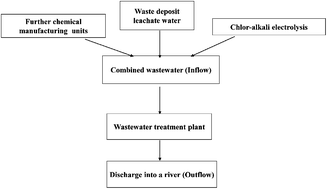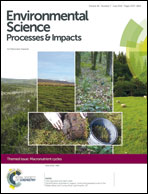Identification of specific organic contaminants in different units of a chemical production site†
Abstract
Due to the very limited number of studies dealing with the chemical composition of industrial wastewaters, many industrial organic contaminants still escape our view and consequently also our control. We present here the chemical characterization of wastewaters from different units of a chemical complex, thereby contributing to the characterization of industrial pollution sources. The chemicals produced in the investigated complex are widely and intensively used and the synthesis processes are common and applied worldwide. The chemical composition of untreated and treated wastewaters from the chemical complex was investigated by applying a non-target screening which allowed for the identification of 39 organic contaminants. According to their application most of them belonged to four groups: (i) unspecific educts or intermediates of industrial syntheses, (ii) chemicals for the manufacturing of pharmaceuticals, (iii) educts for the synthesis of polymers and resins, and (iv) compounds known as typical constituents of municipal sewage. A number of halogenated compounds with unknown toxicity and with very high molecular diversity belonged to the second group. Although these compounds were completely removed or degraded during wastewater treatment, they could be useful as “alarm indicators” for industrial accidents in pharmaceutical manufacturing units or for malfunctions of wastewater treatment plants. Three potential branch-specific indicators for polymer manufacturing were found in the outflow of the complex. Among all compounds, bisphenol A, which was present in the leachate water of the on-site waste deposit, occurred in the highest concentrations of up to 20 000 μg L−1. The comparison of contaminant loads in the inflow and outflow of the on-site wastewater treatment facility showed that most contaminants were completely or at least significantly removed or degraded during the treatment, except two alkylthiols, which were enriched during the treatment process. The chemical composition of the inflow samples showed a very heterogenic composition and strongly varied, reflecting that large scale industrial synthesis is carried out in batches. The outflow contained mainly unspecific chlorinated educts or intermediates of industrial syntheses as well as compounds which are known as typical constituents of municipal wastewaters.


 Please wait while we load your content...
Please wait while we load your content...